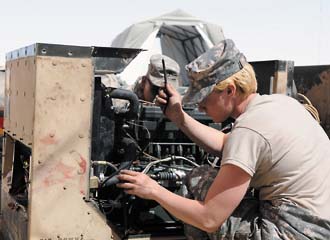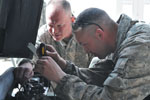Moving Power Closer to The Edge
 |
Pvt. Ginger Lamere, USA, generator mechanic, Company B, Division Special Troops Battalion, 1st Armored Division, reattaches generator hoses and wires after the new engine is installed. The generator’s motor had to be replaced to meet soldiers’ power demands at Camp Liberty. |
The U.S. Defense Department’s point program for tactical electric power is introducing a new generation of power generators that will reduce the fleet average fuel consumption more than 20 percent. The Advanced Medium Mobile Power Sources generators—the handiwork of the U.S. Army’s Project Manager–Mobile Electric Power—is scheduled to enter production early next year and, once fully fielded, will save the Army more than 50 million gallons of fuel annually.
Two additional energy-saving projects will complement this latest innovation. The Large Advanced Mobile Power Sources program is being designed for 100- and 200-kilowatt generators, and the Small Tactical Electric Power program will address the new 1-kilowatt to 3-kilowatt generators; development is planned to begin in 2011 and 2012, respectively.
As in other organizations, the need to discover ways to conserve energy is twofold: save money and decrease dependence on fossil fuels. Focusing work that reduces fuel usage on the battlefield also addresses two problems: shrinking the amount of fuel the Army uses overall and reducing the number of fuel trucks on the road, a dangerous occupation for warfighters in the age of massive numbers of improvised explosive devices.
Justification for investing in these technologies is evident in the numbers. For example, a 2008 Army Science Board report cited conventional electric generators as the Army’s single largest consumer of fuel on the battlefield. Generators in a combat environment consume 357 million gallons of fuel per year—more than aircraft, combat vehicles or tactical vehicles.
Although “green,” “energy conservation” and “carbon footprint” are the latest buzzwords, the Defense Department’s Project Manager–Mobile Electric Power (PM MEP) organization,
The PM MEP operates under the auspices of the Program Executive Office Command, Control and Communications–Tactical (PEO C3T),
“The challenges associated with power and energy have never been greater. Balancing increased operational energy demands with energy security is a particularly challenging problem. ... Given that most of these generators are located at remote sites with resupply lines vulnerable to attack, we must focus our attention on means to reduce fuel consumption requirements. The only way we can achieve this goal is to address the challenge holistically by using a system-of-systems approach to reduce energy demand, improve power generation sources and develop more efficient power distribution systems,” Padden states.
While the explosion of information technology and network-centric warfare in the Army during the past 15 years certainly has improved operational capabilities, it has been at the cost of driving up power consumption, he notes. A trend has emerged in information technology support of command, control, communications, computers, combat systems, intelligence, surveillance and reconnaissance (C5ISR) systems; weapons systems; and logistics sustainment. “This trend is evident by increased battery usage and increased onboard vehicle power requirements at combat outposts as well as in tactical command posts. Yet comparatively speaking, while the overall power consumption of a command post has not varied much, the nature of the consumers in the command posts has varied greatly. This makes it difficult to determine historical trends,” Padden allows.
The dichotomy the PM MEP faces is evident in the way military posts are equipped. For example, computing hardware has evolved from stand-alone Unix-based systems to networked laptops, which draw far less power but are ubiquitous in the command post. Server stacks have migrated from inside rigid wall shelters into transit cases. Shelters required lighting and cooling to run the servers, which added nearly 20 kilowatts to a typical battalion command post’s power demand. Server stacks minus the shelters need more power but do not require lighting and cooling, so the overall power draw for the command post stays fairly constant. “For the future, we anticipate similar types of variations. As the power required for each piece of electronic equipment decreases and more equipment is added, the infrastructure of a command post will have to change to meet the needs of tomorrow’s force,” Padden predicts.
Despite the challenge of unearthing trends to be able to anticipate needs, the PM MEP knows that power requirements are not likely to disappear in the near future. Its current effort, the Advanced Medium Mobile Power Sources (AMMPS), as well as the upcoming Large Advanced Mobile Power Sources program and the Small Tactical Electric Power program are only three of the PM MEP’s efforts aimed at meeting energy requirements.
 |
Spc. Herbert Mekle, USA (l), and Spc. William Crocker, USA, mechanics for Echo Company, 3rd Battalion, 122nd Infantry Division, Vermont Army National Guard, repair a 3-kilowatt generator that powers communications equipment at Forward Operating Base Thunder, Afghanistan. Information technology that supports command, control, communications, computers, combat systems, intelligence, surveillance and reconnaissance systems, weapons systems and logistics may increase the amount of energy operating bases require but still pales in comparison to the energy needed for sustaining troops, including medical and living facilities. |
Padden emphasizes that the
The design would include conventional and alternative energy power sources integrated in a plug-and-play capacity. In addition, it would feature scalable microgrids and intelligent power management capabilities. To achieve this vision, however, advancements in all of these technology areas must continue, Padden states. Achieving this vision also will involve maintaining the PM MEP’s systematic, incremental approach so it can balance operational energy needs, the maturity of technology and costs. Fielding the AMMPS is a significant step in the right direction, he emphasizes.
In addition to these projects, the Defense Department is funding a PM MEP initiative called the Hybrid Intelligent Power Program (HI-Power). Currently under development, HI-Power would identify how to enhance energy security by using intelligent power management and integrating renewable energy technologies. The goal is to reduce fuel and energy consumption in tactical operational environments by incorporating and managing diverse power sources seamlessly, including solar, wind, DC vehicle power, batteries, commercial pole power and military or commercial generators. “The HI-Power architecture will establish a paradigm shift from centralized power generation and distribution to integrated power management in an operational microgrid,” Padden relates.
HI-Power’s intelligent control system would enable power sources to start and stop autonomously depending on existing demand. HI-Power also would incorporate agile degradation during a partial grid or device failure. In addition to featuring self-learning algorithms, HI-Power’s modular and configurable design will allow for different power levels, reduce emissions and noise, and enable seamless integration of current and future renewable energy sources, such as solar and wind power. The PM MEP plans to begin fielding this technology in 2015. Once fully operational, the system will reduce operations and support costs by 25 percent and fuel consumption by 17 percent to 40 percent, Padden states.
In keeping with its incremental approach to designing solutions for the future, the PM MEP currently is evaluating technologies that could be developed starting around 2014; these capabilities would be funded and purchased later in the decade.
Like other organizations, the service wants green solutions for its energy needs. “In most cases, we are searching for renewable energies such as solar, wind, geothermal, bio-mass conversion, hydropower and ocean currents/tidal movement. Each of these sources has its own set of advantages and disadvantages—from technical maturity, efficiency, cost, complexity and location limitations to infrastructure requirements,” Padden admits.
For the operational forces realm, the PM MEP primarily is focusing on the three most mature technologies: solar, wind and waste-to-energy. “However, it is unlikely that renewable energy sources will provide the huge near-term fuel reduction benefits some [people] would suggest. Large-scale solar farms that exceed a single megawatt of power are unlikely to be operationally viable or cost effective for tactical applications due to low efficiencies, cost, space and energy storage requirements, as well as the need for expanded security,” he points out.
Although green alternatives may not be practical for producing mega-power yet, in the near term some already are in the field. For example, soldiers are using manportable solar panels to recharge batteries, and small isolated outposts are employing solar technologies for limited but critical C5ISR support, particularly for communications and sensors.
Despite these advances, the Army still must find power solutions that are feasible on the road and in desolate environments because those are the most likely places it will find itself working. More research is required in the area of alternative energy sources that are more efficient, lighter, more durable and most cost effective because fuel and water distribution currently make up 70 percent of Army logistics. “In the end, the goal is to untether the Army from the logistics tail,” Padden relates.
To address this particular challenge, the PM MEP is working with the Army Communications-Electronics Research, Development and Engineering Command on a number of demonstrations that explore and validate new technologies. These power-producing alternatives include hybrid power prototypes with an energy storage capability; co-generation systems that use waste heat to produce either electricity or operate environmental control units; and integrated photovoltaic systems. “The primary challenge associated with these types of programs is to mature technology readiness, quantify military utility and develop a supporting business-case analysis. Only then can a valid user requirement be established and resourced to realize this vision,” he states.
Padden believes that businesses have as much to gain as the military by investing their research dollars into some specific areas because if a military need exists, it is likely that a profitable commercial application exists as well. He encourages industry to pursue work on energy storage devices, power generation and conversion systems including alternative energy systems, and power control and distribution systems.
Industry-government partnerships are not new to the PM MEP. As one of the founding members of the Electrical Generating Systems Association, it is part of this forum that fosters industry and military cooperation and coordination in the area of power generation. The association also acts as a medium for vetting requirements, continuing professional development, soliciting input on technology development and informing members about upcoming business opportunities.
WEB RESOURCES
Project Manager–Mobile Electric Power: www.pm-mep.army.mil
Program Executive Office Command, Control and Communications–Tactical: http://peoc3t.monmouth.army.mil ; e-mail SFAE-C3T-TILO@conus.army.mil
Electrical Generating Systems Association: www.egsa.org




Comments